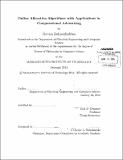| dc.contributor.advisor | Erik D. Demaine. | en_US |
| dc.contributor.author | Zadimoghaddam, Morteza | en_US |
| dc.contributor.other | Massachusetts Institute of Technology. Department of Electrical Engineering and Computer Science. | en_US |
| dc.date.accessioned | 2014-06-13T22:34:43Z | |
| dc.date.available | 2014-06-13T22:34:43Z | |
| dc.date.copyright | 2014 | en_US |
| dc.date.issued | 2014 | en_US |
| dc.identifier.uri | http://hdl.handle.net/1721.1/87940 | |
| dc.description | Thesis: Ph. D., Massachusetts Institute of Technology, Department of Electrical Engineering and Computer Science, 2014. | en_US |
| dc.description | Cataloged from PDF version of thesis. | en_US |
| dc.description | Includes bibliographical references (pages 99-107). | en_US |
| dc.description.abstract | Over the last few decades, a wide variety of allocation markets emerged from the Internet and introduced interesting algorithmic challenges, e.g., ad auctions, online dating markets, matching skilled workers to jobs, etc. I focus on the use of allocation algorithms in computational advertising as it is the quintessential application of my research. I will also touch on the classic secretary problem with submodular utility functions, and show that how it is related to advertiser's optimization problem in computational advertising applications. In all these practical situations, we should focus on solving the allocation problems in an online setting since the input is being revealed during the course of the algorithm, and at the same time we should make irrevocable decisions. We can formalize these types of computational advertising problems as follows. We are given a set of online items, arriving one by one, and a set of advertisers where each advertiser specifies how much she wants to pay for each of the online items. The goal is to allocate online items to advertisers to maximize some objective function like the total revenue, or the total quality of the allocation. There are two main classes of extensively studied problems in this context: budgeted allocation (a.k.a. the adwords problem) and display ad problems. Each advertiser is constrained by an overall budget limit, the maximum total amount she can pay in the first class, and by some positive integer capacity, the maximum number of online items we can assign to her in the second class. | en_US |
| dc.description.statementofresponsibility | by Morteza Zadimoghaddam. | en_US |
| dc.format.extent | 107 pages | en_US |
| dc.language.iso | eng | en_US |
| dc.publisher | Massachusetts Institute of Technology | en_US |
| dc.rights | M.I.T. theses are protected by copyright. They may be viewed from this source for any purpose, but reproduction or distribution in any format is prohibited without written permission. See provided URL for inquiries about permission. | en_US |
| dc.rights.uri | http://dspace.mit.edu/handle/1721.1/7582 | en_US |
| dc.subject | Electrical Engineering and Computer Science. | en_US |
| dc.title | Online allocation algorithms with applications in computational advertising | en_US |
| dc.type | Thesis | en_US |
| dc.description.degree | Ph. D. | en_US |
| dc.contributor.department | Massachusetts Institute of Technology. Department of Electrical Engineering and Computer Science | |
| dc.identifier.oclc | 880284018 | en_US |
